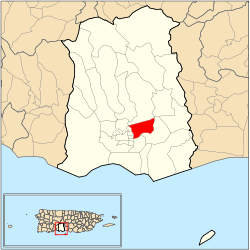Machuelo Abajo
Machuelo Abajo is one of the 31 barrios of the municipality of Ponce, Puerto Rico. Along with Canas Urbano, Magueyes Urbano, Portugués Urbano, and San Antón, Machuelo Abajo is one of the municipality's five originally rural barrios that are now also part of the urban zone of the city of Ponce. It was founded in 1818.[3][4]
Machuelo Abajo | |
|---|---|
Barrio | |
.jpg) Street scene in southern Barrio Machuelo Abajo, in the city of Ponce | |
 Location of barrio Machuelo Abajo within the municipality of Ponce shown in red | |
| Coordinates: 18°01′30″N 66°35′46″W[1] | |
| Commonwealth | |
| Municipality | |
| Area | |
| • Total | 1.86 sq mi (4.8 km2) |
| • Land | 1.79 sq mi (4.6 km2) |
| • Water | 0.07 sq mi (0.2 km2) |
| Elevation | 85 ft (26 m) |
| Population (2010) | |
| • Total | 11,855 |
| • Density | 6,622.9/sq mi (2,557.1/km2) |
| Source: 2010 Census | |
Location
Machuelo Abajo is an urban barrio located in the southern section of the municipality, in the northeast portion of the city of Ponce, within the Ponce city limits, at latitude 18.024217 N, and longitude -66.600217 W.[5]
Boundaries
Machuelo Abajo is bounded on the North by Tito Castro Avenue/PR-14 (roughly), on the South by Miguel Pou Boulevard (roughly), and Abaisin Street, on the West by Rio Portugues, and on the East by Los Negrones Hill, Rio Bucana, and Emilio Fagot Street (roughly).[6][7]
In terms of barrio-to-barrio boundaries, Machuelo Abajo is bounded in the North by Machuelo Arriba, in the South by San Anton and Sabanetas, in the West by Quinto and Sexto, and in the East by Sabanetas.
Features and demographics
.jpg)
Machuelo Abajo is home to the communities of Jardines Fagot, La Rambla, La Alhambra, Extension La Alhambra, Flamboyanes, Bella Vista, Santa Clara, and Riberas del Bucana.[8] In addition the communities of Residencial Dr. Pila, Villa Esperanza, and Valle Verde, make their home there as well.[9]
Machuelo Abajo has 1.77 square miles (4.6 km2) of land area and 0.09 square miles (230,000 m2) of water area.[10] In 2000, the population of Machuelo Abajo was 13,302 persons, and it had a density of 7,522 persons per square mile.[11][12]
In 2010, the population of Machuelo Abajo was 11,855 persons, and it had a density of 6,622.9 persons per square mile.[13]
The highest point in Barrio Machuelo Abajo is Cerro Los Negrones at 397 feet, located northwest of Mercedita Airport.[14]
Notable Landmarks
Río Bucaná runs a stretch of its course (channelized) through barrio Machuelo Abajo. The new Hospital San Lucas is located in Machuelo Abajo where the old Ponce District Hospital was located on Puerto Rico Highway 14.[15]
Notable people from Machuelo Abajo
See also
References
- "US Gazetteer 2019". US Census. US Government.
- U.S. Geological Survey Geographic Names Information System: Machuelo Abajo barrio
- Eli D. Oquendo-Rodriguez. Los Barrios de Ponce: Noticias y Microhistorias de Ocho Comunidades Ponceñas en el Tiempo, Siglos XVI al XIX. 2019. p. 125.ISBN 9781076759153
- Barrios de Ponce. Archived 30 September 2015 at the Wayback Machine Antepasados Esclavos.(From: Pedro Tomás de Córdoba. Memorias geográficas, históricas, económicas y estadísticas de la Isla de Puerto Rico.) Retrieved 28 November 2014.
- City Melt Retrieved March 2, 2010.
- General Purpose Population Data, Census 2000. Unidad de Sistemas de Información Geográfica, Área de Tecnología de Información Gubernamental, Oficina de Gerencia y Presupuesto. Gobierno de Puerto Rico. Archived 2010-08-12 at the Wayback Machine Retrieved March 2, 2010.
- Ponce Topographic Map. Map Styles: Map and Shaded. Trails.com. From: United States Geological Survey. Topo Map. Projection: NAD83/WGS84. Retrieved March 2, 2010.
- Rebaja $46 millones la Alcaldía ponceña. Jason Rodríguez Grafal . La Perla del Sur. Ponce, Puerto Rico. 30 May 2012. Year 30. Issue 1487. Page 14. Retrieved 9 June 2012.
- Ponce Topographic Map. Map Styles: Map and Shaded. Trails.com. From: United States Geological Survey. Topo Map. Projection: NAD83/WGS84. Retrieved March 2, 2010.
- Ponce Municipio, Puerto Rico -- County Subdivision and Place: GCT-PH1. Population, Housing Units, Area, and Density: 2000 (Data Set: Census 2000 Summary File 1 (SF 1) 100-Percent Data) Archived 10 February 2020 at Archive.today Retrieved March 2, 2010.
- Ponce, Puerto Rico: Barrios. Areciboweb. Retrieved, February 14, 2010.
- Ponce Municipio, Puerto Rico -- County Subdivision and Place: GCT-PH1. Population, Housing Units, Area, and Density: 2000 (Data Set: Census 2000 Summary File 1 (SF 1) 100-Percent Data) Archived 10 February 2020 at Archive.today Retrieved March 2, 2010.
- Puerto Rico:2010:population and housing unit counts.pdf (PDF). U.S. Dept. of Commerce, Economics and Statistics Administration, U.S. Census Bureau. 2010.
- Maptest. Archived 2010-02-18 at the Wayback Machine Government of the Commonwealth of Puerto Rico. General Purpose Population Data, Census 2000. Unidad de Sistemas de Información Geográfica, Área de Tecnología de Información Gubernamental, Oficina de Gerencia y Presupuesto. Gobierno de Puerto Rico. Retrieved 10 November 2011.
- General Purpose Population Data, Census 2000. Unidad de Sistemas de Información Geográfica, Área de Tecnología de Información Gubernamental, Oficina de Gerencia y Presupuesto. Gobierno de Puerto Rico. Archived 2010-08-12 at the Wayback Machine Retrieved February 20, 2010.
- Carmelo Rosario Natal. Ponce En Su Historia Moderna: 1945-2002. Secretaría de Cultura y Turismo, Government of the Autonomous Municipality of Ponce. Ponce, Puerto Rico. 2003. p. 252.
- Victor Federico Torres. Yo quiero que me olviden: la historia de Marta Romero. Río Piedras, Puerto Rico : Publicaciones Gaviota, 2014. P.7.
- Sergio Santana Archbold. Héctor Lavoe, la voz del barrio. Medellín, Colombia: Ediciones Rumbantana, 2003. p.71.